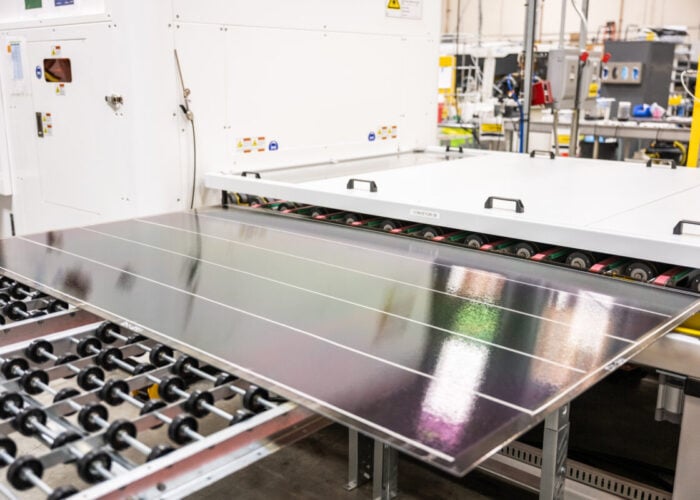
The tax credit transfer market for renewable energy projects unlocked by the US Inflation Reduction Act (IRA) has started to thrive as predicted with several types of deal, including innovative hybrid deals now in play, according to a prominent lawyer in renewable energy and private equity.
There are three categories of deal currently being used for these renewable energy projects including direct transfer, debt-plus-transfer, and hybrid tax equity, Carl Fleming, a Washington DC-based partner at law firm McDermott Will & Emery, tells PV Tech Premium.
Unlock unlimited access for 12 whole months of distinctive global analysis
Photovoltaics International is now included.
- Regular insight and analysis of the industry’s biggest developments
- In-depth interviews with the industry’s leading figures
- Unlimited digital access to the PV Tech Power journal catalogue
- Unlimited digital access to the Photovoltaics International journal catalogue
- Access to more than 1,000 technical papers
- Discounts on Solar Media’s portfolio of events, in-person and virtual
For the nearly three dozen post-IRA transactions that McDermott has worked on in this wave of new deal structures, the debt-plus-transfer market has proven to be dominated by very large standalone energy storage deals. The direct transfer transactions have been predominately storage deals but also a significant number of solar. And hybrid tax equity deals have been spread quite evenly across storage, solar and wind.
Back in March, PV Tech Premium reported that under the IRA, the ability for solar and other renewable energy projects to transfer tax credits had created a whole new marketplace, triggering what Fleming called the “great rethink” of the energy markets. With developers having been given the flexibility to sell all or a portion of the credits to third parties, new corporate entities could now move in and become the emerging new investor in such projects.
Direct and debt-plus transfers
McDermott, as the first firm to close a direct transfer back in January, continues to be the frontrunner in this space. It has worked on over 25 direct transfer deals where a developer transfers credits typically to a corporate buyer. Fleming says his firm is facilitating such deals ranging from US$30 million to US$300 million with big household names including Fortune 500 companies, who see this is a useful tax mitigation instrument.
Direct transfers have then altered the debt markets in the form of adding debt-plus-transfer deals as a new option for projects that may have previously struggled to secure tax equity to support construction debt. This is proving to be particularly suited to large standalone storage projects at present. Fleming points to the Texas market run by grid operator ERCOT, as an example, where there is high volatility as well as uncertainties around offtake and when projects will become profitable.
Now, McDermott is working on around six debt-plus-transfer transactions where the construction of the storage project can be financed alongside a commitment to transfer the credits to another corporate buyer, reducing some of the exposure to this market volatility.
“Between the construction debt and the transfer, the transfer, to a degree, has taken the place of a tax equity. That’s a nice avenue for standalone storage,” adds Fleming.
Hybrid tax equity
The third type of transaction, the hybrid tax equity deal, is a traditional tax equity joint venture, but now, instead of just being an equity investment, the parties can transfer out some of those credits or part of the investment. There are multiple benefits in that developers can tailor the transaction to optimise their projects and investors need not allocate all their capacity into just one project but can instead transfer credits to their corporate clients, helping to spread the risk and allowing investors to do more deals with other projects.
McDermott is working on a dozen such hybrid tax equity deals, says Fleming. All the tax equity investors in these cases have asked for some ability to transfer out their tax equity investment. Firstly, this allows them – depending on the tax equity investor – to service their corporate clients, and secondly it allows them to sign up to more tax equity deals. Even though they are committing to a certain investment figure up front, they can still freely transfer out what they need to make other deals.
In these cases, it’s a “win-win-win for each of the developer, tax equity investor and corporate transferee”, says Fleming.
All in one
McDermott is now leading a large number of “mega” transactions for several very sophisticated clients, each of which contains the “Full Monty of everything IRA related”, according to Fleming. These are headline-sized energy storage and/or solar projects with optionality for a debt-plus-transfer facility, a hybrid tax equity facility, and a direct transfer facility all built in.
These mega deals work synergistically like three transactions under one larger umbrella transaction to provide optionality for the developer to optimise project economics when it brings each project to the market, claims Fleming.
“To do it all together and under one roof makes sense because you can’t have different counterparts working on different fragments who don’t quite understand how it all gels. Such a sophisticated structure requires an equally sophisticated team to execute,” he adds.
Fleming notes that each sub-part of these complex transactions is driven by the most efficient use of the new tax credit transfer mechanism under the IRA to help clients monetise those credits. He credits McDermott’s dedicated renewable energy tax credit team, led by Phil Tingle and Heather Cooper, for the group’s leadership in this area.
“Phil and Heather have been doing this for decades in the state tax credit transfer market and quickly jumped on the new federal tax credits,” says Fleming.
Market efficiency
The tax credit transfer market has come together much more quickly than many had expected. Despite progress so far, this federal tax credit transferability is still a novel investing landscape for most parties and the market has room to gain efficiencies. Fleming says he has seen a divergence in the type of buyers. Some corporates are already well-versed in state tax credits so, they can transfer their understanding and experience into these new transactions despite certain differences. However, there are other buyers who have less state tax credit experience that require more of a learning curve and these transactions can take longer to complete.
“It’s not a pitfall by any means, but you just have to understand who’s involved as you’re putting these things together,” says Fleming.
The same can be said of a handful of developers who may assume that the transfer process will be unreasonably quick given that it is cheaper and more simplified than a traditional tax equity transaction.
“We can certainly do this faster, do it cheaper and do more of them,” says Fleming. “However, it’s not incredibly simplistic, where you can just sign this up in a weekend. It can take a few weeks which is a fraction of the time of traditional tax equity deals. But people will likely haggle over some of the indemnities, the reps, warranties and insurance, so you have to package this thing, which we have. And commercially, everyone’s got to come around to it. So that can take longer for some deals than others.”
Likewise, Fleming warns that hybrid tax equity deals specifically introduce a new party to an already complex arrangement, which creates another stakeholder in the deal to be mindful of throughout the whole transaction.
“You may get a lot of cooks in the kitchen, if you will. Everyone adds value and everyone’s got the same end game – a successful transaction for all – but different pressure points. So, for some deals, it can take a little longer to get that deal done while people get up to speed while others can be incredibly efficient,” says Fleming.
Given how advantageous credit transfers can be, there has also been a newer trend of tax equity investors asking to reopen prior tax-equity-only investments, which at the time of completion did not have a transferability option. Thus, McDermott has already been involved in some renegotiations on these previously closed transactions. This has proven to be a good thing since both parties can sit down and evaluate whether transferability can provide any further benefits upon the prior transaction.
The broker market
There is now an active broker market in this space too where several brokers are putting developers and buyers in touch, some of whom are adding value by pre-vetting the transactions or helping with the commercial explanations to counterparts.
Online marketplace for clean energy tax credits, Atheva, for example, announced last week that it had facilitated five transfers via its website in October. Atheva co-founder Seth Feuerstein describes the platform as “a very high-end eBay that’s targeted towards tax credits”.
The transferability allows more solar developers, particularly with lower amounts of tax credits to transfer, to be able to monetise their credits, he says. Some players in the past had large amounts of credits and could do expensive tax equity deals, but many smaller projects, likely below the US$30 million threshold that seems to be forming for the greater direct transfer market, couldn’t get the credits and ended up entering leasing deals or some form of tax equity deal, often losing a lot of the tax credit in the process.
“By creating this simple transferability process, the solar developers particularly at the lower end should be able to monetise the credits at much higher amounts and retain more money, which obviously means that they can then finance more solar deals,” adds Feuerstein.







